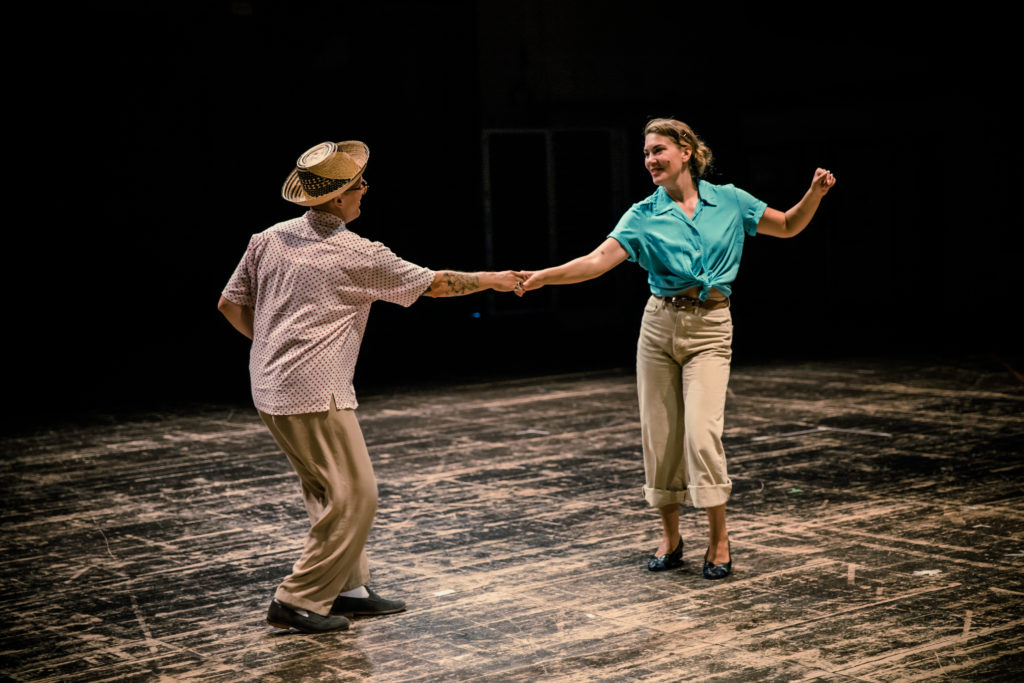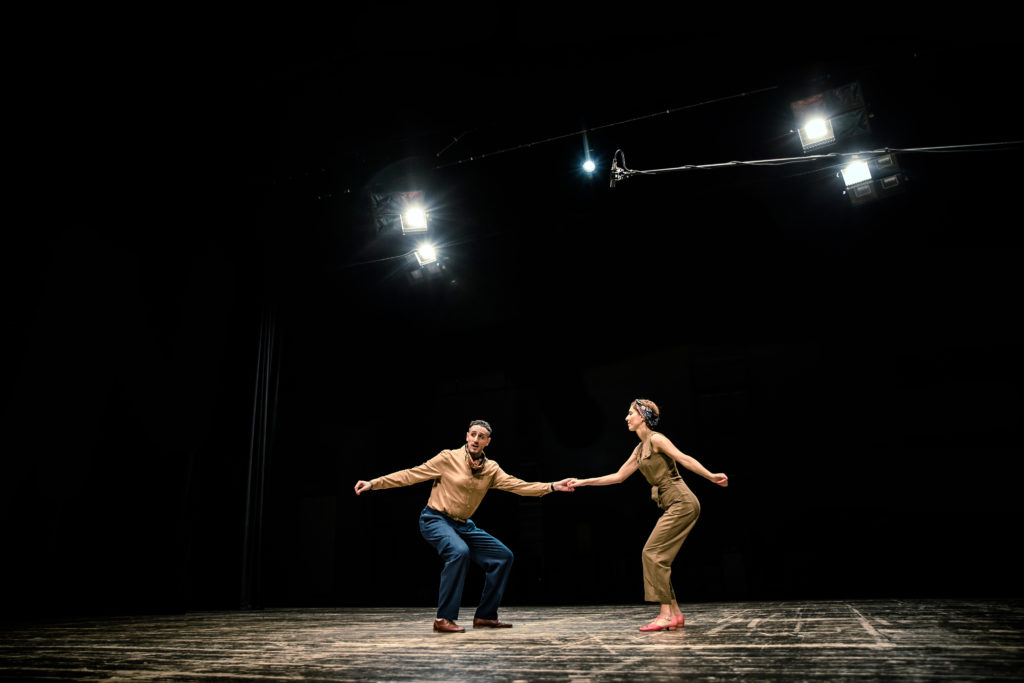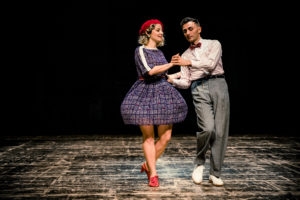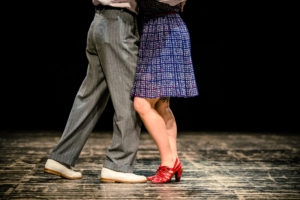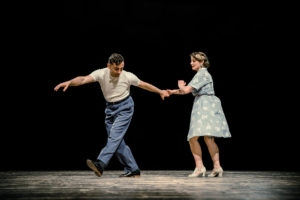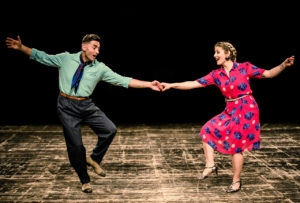The term Boogie Woogie indicates both a dance and musical style. The music has its roots in the Blues and is characterized by a frenetic and driving rhythm most commonly associated with the piano.
The dance evolved a little later and was heavily influenced by Swing dances of the time like Lindy Hop and Jitterbug and would eventually go on to become a hugely popular dancesport sensation.
History and origins of Boogie Woogie
The origins of Boogie Woogie as a musical style can be traced back to the USA in the late 1800s, in particular to the southern State of Texas. It was a musical style popular amongst the African-American communities, and associated with house parties and drinking establishments.
Back then the style was known as ‘Fast Western’, or ‘Fast Texas’, or even ‘Barrelhouse’, as a reference to the venues or ‘cheap saloons’ in which it was played where the beer was served from barrels.
The term ‘Boogie Woogie’ has very interesting origins, with common theories citing the African words Boog and Booga (meaning to beat, a drum for example), and the West African word Boogi (meaning to dance) as the direct provenance.
Another theory speculates it could have evolved from the Bantu phrase Mbuki mvuki, meaning to shake off one’s clothes and dance. And another equally viable suggestion is that it is simply the repetition of the word Boogie, which in America in the early 20th Century was used to mean ‘rent party’ (the kind of event at which Boogie Woogie would definitely have played), and was at the same time a colloquial sexual reference.
In addition, perhaps it is mere coincidence that the British word ‘bogie’ refers to the wheels of a locomotive, when the railroad played such a significant part in the history of Boogie Woogie, both in terms of the influence that the sounds of the emerging railways had on the actual creation of the music (relentless driving rhythms), and the new possibility of travel that it offered, transporting struggling musicians from town to town and eventually into bigger cities, spreading the music around the State of Texas, and then into the surrounding States.
Slowly yet surely the music spread.
There is much debate about the first recorded Boogie Woogie songs, in 1928 however, Pinetop Smith released “Pinetop’s Boogie Woogie” and made Boogie Woogie history. It was the first proper Boogie Woogie hit, and it launched the musical genre into the public domain like never before.
Boogie Woogie really got its break though in 1938 when top pianists Big Joe Turner, Albert Ammons, Pete Johnson and Meade Lux Lewis played at the concert “From Spirituals to Swing” at Carnegie Hall in New York.
From that moment on, Boogie Woogie was everywhere. Big Band Orchestras began to incorporate the style into their own music and with great success.
Tommy Dorsey, Benny Goodman and Will Bradley all had hit records with Boogie Woogie style songs in the late 1930s and early 1940s, and in 1941 even the Andrews Sisters got in on the act with their hit Boogie Woogie Bugle Boy.
It conquered the hearts of a nation. Boogie Woogie remained popular throughout the 1940s until towards the end of the decade when the music began to evolve into Rhythm’n’Blues (amongst other styles) and came to be reincarnated as Rock’n’Roll.
Boogie Woogie in Art
Boogie Woogie music experienced such popularity in its heyday that it also influenced and inspired artists of the time: in the 1940s the famous Dutch painter Piet Mondrian entitled two of his canvases, “Broadway Boogie-woogie” and “Victory-Boogie-woogie”.
And about ten years later the Italian artist Renato Guttuso also decided to name one of his most famous works “Boogie-woogie“, helping to immortalize the larger than life character of an unforgettable style and movement.
Boogie Woogie music
Despite originating from the Blues, Boogie Woogie is characteristically very powerful, lively, and infectiously upbeat.
It is most often associated with the piano where the left hand reproduces syncopated and repetitive notes that drive the rolling rhythm (and give that distinctive train sound), and the right hand carries the melody/ies, which compliment and syncopate the rhythms of the left hand.
It is incredibly complex, but when put together, is pure alchemy, and practically irresistible to dance to!
In fact in the early days when the very first Boogie Woogie piano players performed in small clubs, they had two main objectives, to entertain and to make the people dance, and to achieve that it was almost like they became a real “one-man band“, providing the bass, the melody, and the solo all at the same time!
Boogie Woogie dance
Although its music had its beginnings in the 1870s, and its glory period from the 1920s to the 1940s, the dance didn’t emerge until a little later. The dance known as Boogie Woogie took influence from what was danced to Rock’n’Roll music in the 1950s, and has certain similarities to Lindy Hop.
Back in the day it would probably just have been known as ‘Rock’n’Roll’. When Swing dancing arrived in Europe in the 1940s, it was love at first sight, and the craze spread like wildfire. When the war ended and the 1950s arrived heralding the ‘all new’ sounds of Rock’n’Roll, the dance (which would have been similar to the Jitterbug) fitted the music perfectly, and could be easily danced to these new faster rhythms.
Some European countries weren’t so keen on its free and improvisational nature however, and standardized the dance creating rules and a structure to adhere to.
Skip forward 20 years and although the dance was no longer the height of fashion, it still had quite a following.
So much so in fact that a group of European dancers decided to dance it competitively. In 1974 the first international dance competitions of their kind were held between France, Italy, Germany, and Switzerland, leading to the formation of the World Rock’n’Roll Confederation in 1984.
Rumor has it that it was the WRRC that gave the dance style ‘Boogie Woogie’ its name, partly because the name ‘Acrobatic Rock’n’Roll’ already existed for a different style, and partly in reference to the roots and heritage of the dance, and the music it was frequently danced to.
Today, in the 21st Century, ‘Boogie Woogie’ is an extremely popular social and competitive dance that while intrinsically linked to the historic Swing dances of the 30s and 40s, has developed a distinct European identity.
The most similar dance that exists in the United States is what is known as ‘East Coast Swing’, and this is also a standardized interpretation of the Swing dances of the 1930s and 1940s.
How to dance Boogie Woogie
Boogie Woogie is an improvised partner dance that developed from Lindy Hop and Swing.
It isn’t choreographed, however it does have a clear structure, technique, and well-defined sequences of steps that draw inspiration from Lindy Hop, and other Swing styles.
Originally it was danced to Rock’n’Roll and Rhythm and Blues, however it is also synonymous with Boogie Woogie music (of course!). It has a reputation for being one of the most lively and energetic Swing dances, however it can be danced to both fast and slow tempos.
The Basics
Boogie Woogie can be intimidating to a first-timer, especially if one has ever seen a ‘Fast Boogie Woogie‘ championship!
But the dance itself is relatively simple and straightforward, and suitable for all ages!
Being a partner dance, the leader determines all moves, and the follower must interpret the leader’s movements in order to follow the rhythms and steps. Posture is low, knees are soft and bent, and each step is accompanied by a small pulse or bounce. It is important to always spring downwards, working the balls of the feet, the ankles, and the knees.
Here are the basics outlined and explained:
Partners can begin dancing an open position facing each other (handshake distance apart), connected by their hands: leader’s left to follow’s right. Usually the 6 beat basic sequence starts with a change of weight. This is a step immediately followed by a change of weight back to the other foot. The leader always begins (i.e. always steps) with the left foot, and the follower always begins (steps) with the right foot.
This ‘rocking’ motion is made over the count of two beats.
The footwork for a six count basic is as follows:
Beats 1 – 2 : Step-step
Beats 3 – 4 : Triple step
Beats 5 – 6 : Triple step
A ‘triple-step’ is three steps that are made over the count of two beats.
It is also common to see the Step-step (of beats 1 – 2) replaced with a more elaborate kick-ball-change, which helps to generate even more energy for the successive steps.
Once you have mastered this basic rhythm and 6 beat sequence, you are ready to explore the wild and wonderful world of Boogie Woogie!
What is the difference between Boogie Woogie and Lindy Hop?
At first glance Boogie Woogie and Lindy Hop may seem very similar, however they do have several differences:
- Lindy Hop is danced primarily (although not exclusively) to an 8 beat rhythm, whereas Boogie Woogie is danced primarily (although not exclusively) to a 6 beat rhythm;
- Boogie Woogie is a standardized dance, meaning that there are ‘rules’ to follow, whereas Lindy Hop is much more free and does not adhere to a set structure;
- Boogie Woogie tends to be danced more ‘on the toes’, and brings up the knees pretty high compared to Lindy Hop which is much more relaxed in posture;
- and Boogie Woogie is inspired by the ‘Rock’n’Roll’ music of the 1950s, whilst Lindy Hop was inspired by the Swing music of the 1920s through to the 1940s.
That is not to say however that Boogie Woogie can’t be danced to Swing music, or that Lindy Hop can’t be danced to Rock’n’Roll music!
At times the names and labels that are applied to styles of music and dance can obscure and distract from the very important premise that they are all social dances, that all share the same origins, and all share the unique ability to allow people to connect, have fun, and express themselves to exhilarating and inspiring rhythms, and ultimately that is much more meaningful than their differences.
Courses to learn Boogie Woogie
It’s never too late to learn to dance, especially when it comes to Boogie Woogie: and that is exactly why the Summer Jamboree offers courses in Boogie Woogie suitable for all, and a whole lotta fun!

Learn How To
Take a look at our Dance Academy.
Start from scratch or reignite your passion for swing with internationally renowned teachers.
Famous Boogie Woogie songs
Boogie Woogie has such a long and illustrious history, that there is no shortage of celebrated and memorable songs.
Amongst them are:
- Honkey Tonk Train Blues Mead Lux Lewis,
- Yancey Stomp Jimmy Yancy,
- Boogie Woogie Man Albert Ammons & Pete Johnson,
- Screamin’ the Boogie Sonny Thompson and his Orchestra,
- Scrub Me Mama with a Boogie Beat Will Bradley and his Orchestra,
- Pinetop’s Boogie Pinetop Perkins,
- Boogie Woogie Jimmy Rushing,
- Number’s Boogie Sugar Chile Robinson,
- Cleo’s Boogie Cleo Brown,
- Boogie Woogie Maxixe Bob Crosby & Joe Sullivan,
- Indian Boogie Woogie Woody Herman,
and many, many, more…
Concluding thoughts
It has influenced the lives and lifestyles of entire generations and has got literally millions of people dancing, be it socially or competitively.
Boogie Woogie remains one of the most fun-filled and enjoyable dances there is, uniting professional dancers and eager beginners with a simple common passion: a love of music!

